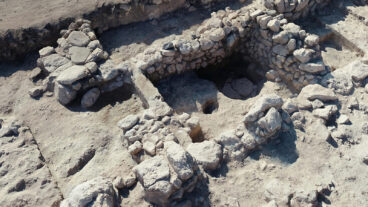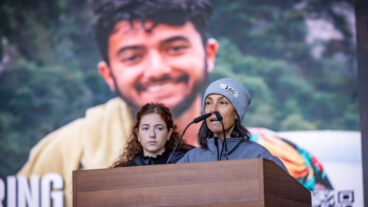Israel this week enters a week-long period of solemnity, with Holocaust Martyrs & Heroes Day commencing on the eve of May 1, and Memorial Day for the Fallen Soldiers of Israel and Victims of Terrorism on the eve of May 7.
Each of these memorial days is marked by moments of silence when the entire country comes to a standstill; special television and radio broadcasts; and official ceremonies and private gatherings where people visit the graves of their family members to honor them.
Some of those gravesites, however, remain unvisited. The tumultuous history of the modern State of Israel created a situation in which there are hundreds of incomplete headstones of men and women who fell in various military operations before and during the creation of the state in 1948.
Most of the fallen were European immigrants who arrived alone to Mandatory Palestine. Because of the Holocaust, they were sometimes the last remaining members of their families. Their gravestones may have only a name but lack information such as the names of parents, date and place of birth, and additional biographical facts.
Headstones and memorial markers convey information about the deceased: family history, religion, marital status, military service, profession, social standing – sometimes even character and personality.
Jewish tombstones with Hebrew inscriptions have an added value to genealogists, as they also include the given name of the deceased’s parents (or at least the father), enabling researchers to go up an additional generation on the family tree.
Non-profit organization Giving a Face to the Fallen devotes itself to researching these crucial pieces of information. Using genealogical tools, libraries, archives and other resources, the organization has mobilized a team of volunteers committed to filling in the missing facts of every life story.
The ultimate goal is to add the information to the Ministry of Defense’s database and Yizkor (Remembrance) website, replace tombstones lacking information, and, when possible, locate and connect with the families of soldiers – wherever they may be in the world.
To date, out of a list of 861 names of fallen soldiers about whom there was little to no information, Giving a Face to the Fallen’s volunteers have filled in the biographical details of more than 100. In some cases, a new tombstone has been made to replace the old one.
Giving a Face to the Fallen was instrumental in locating the relatives of 140 soldiers in the Jewish Brigade of the British Army who drowned in May 1943 when the SS Erinpura was bombed by the Germans off the Libyan coast. A memorial service was finally held this March.
Giving a Face to the Fallen also provides headstone refurbishment support to families whose relatives fell in military operations in pre-state Israel but are interred in non-military cemeteries, and provides research assistance to the IDF Eitan Unit, which is responsible for locating MIA soldiers by helping to find living family members so as to obtain DNA samples.
Digitizing cemeteries
Such updates are welcome news for another team devoted to the key role that gravestones play in family history and society.
Five years ago, Israeli online genealogy platform and DNA testing service provider MyHeritage teamed up with Utah-based BillionGraves, the world’s largest resource for searchable GPS cemetery data, with the ambitious goal of digitizing every cemetery in Israel.
The project has now been completed, making Israel the first country in the world to have almost all of its gravestones preserved and searchable online, with images, locations and fully transcribed records, available free-of-charge.
The easy-to-use BillionGraves application, available for iOS and Android, allows users to upload photographs of gravestones and automatically captures its exact GPS coordinates.
Photos and coordinates are uploaded to a central database for other volunteers to transcribe the information. These records are then added to the MyHeritage and BillionGraves databases, resulting in searchable digital data available for free.
MyHeritage record-matching technology automatically notifies users on MyHeritage and Geni (MyHeritage’s genealogy and social networking website) whenever a gravestone has been added for one of their ancestors.
In February 2014, MyHeritage kicked off the effort by digitizing Segula Cemetery, one of the oldest cemeteries in Israel. The staff took 73,000 photos that were indexed shortly afterwards. A few months later, the more than 200,000 graves in Israel’s largest cemetery, Holon Cemetery, were added to the project.
MyHeritage hired half a dozen full-time photographers and several dozen transcribers, at an investment of $1 million, to photograph headstones in 638 cemeteries throughout Israel. About 2.1 million photos were taken of 1.5 million gravestones, or approximately 1.4 photos per grave.
Sadly, some of the casualties being investigated by Giving a Face to the Fallen are classified as Missing in Action and have no tombstone that could be photographed and digitized. In those cases, the volunteer researchers help perpetuate their memory through arranging memorial ceremonies, producing photo albums, booklets and school programs, and adding updated information to the Yizkor website.
MyHeritage and BillionGraves are seeking more volunteers to help digitally preserve the world’s cemeteries, either by photographing gravestones locally and/or transcribing the all-important names, dates and other information. Visit their websites for more information.
For information on how to help the Giving a Face to the Fallen project, click here.
















![Elections 1977 – Likud posters] In 1977, Menahem Begin led an election upset as Israel’s first non-Labor prime minister. Credit: GPO Elections 1977 – Likud posters] In 1977, Menahem Begin led an election upset as Israel’s first non-Labor prime minister. Credit: GPO](https://static.israel21c.org/www/uploads/2019/09/Elections_1977___Likud_posters_-_GPO-768x432.jpg)
